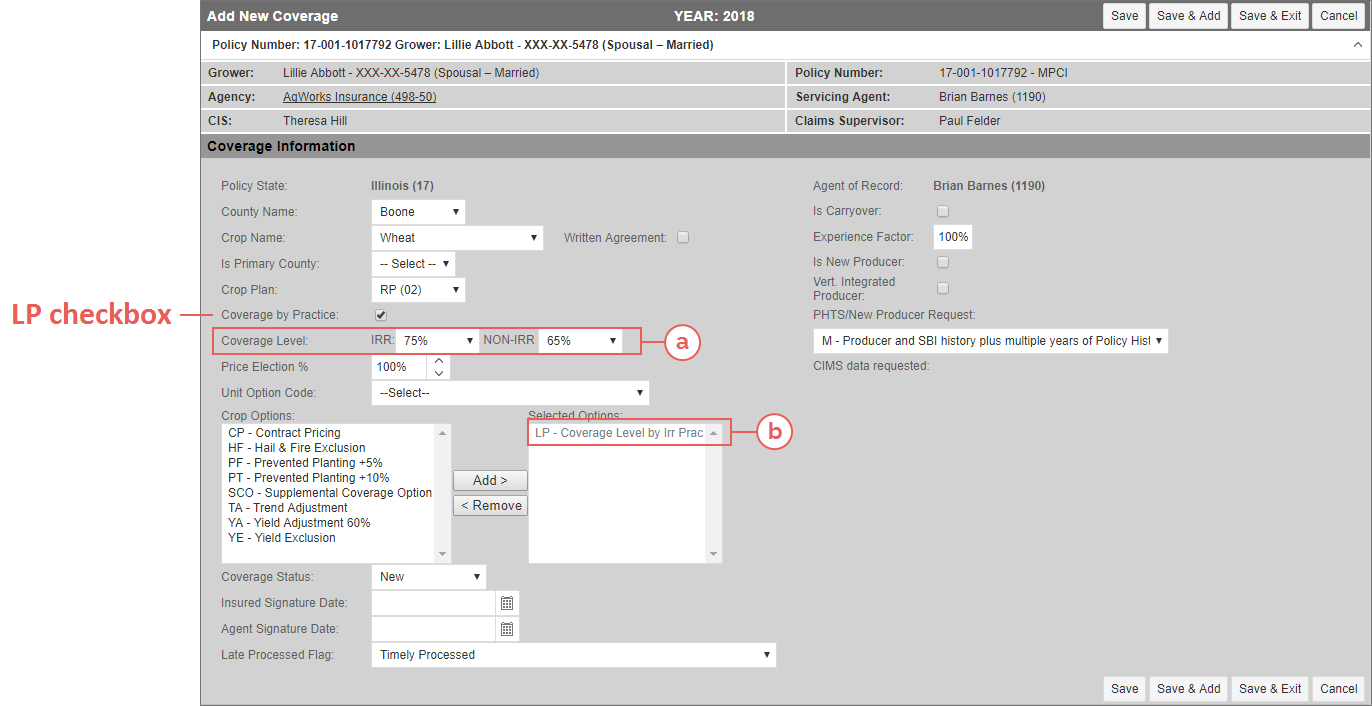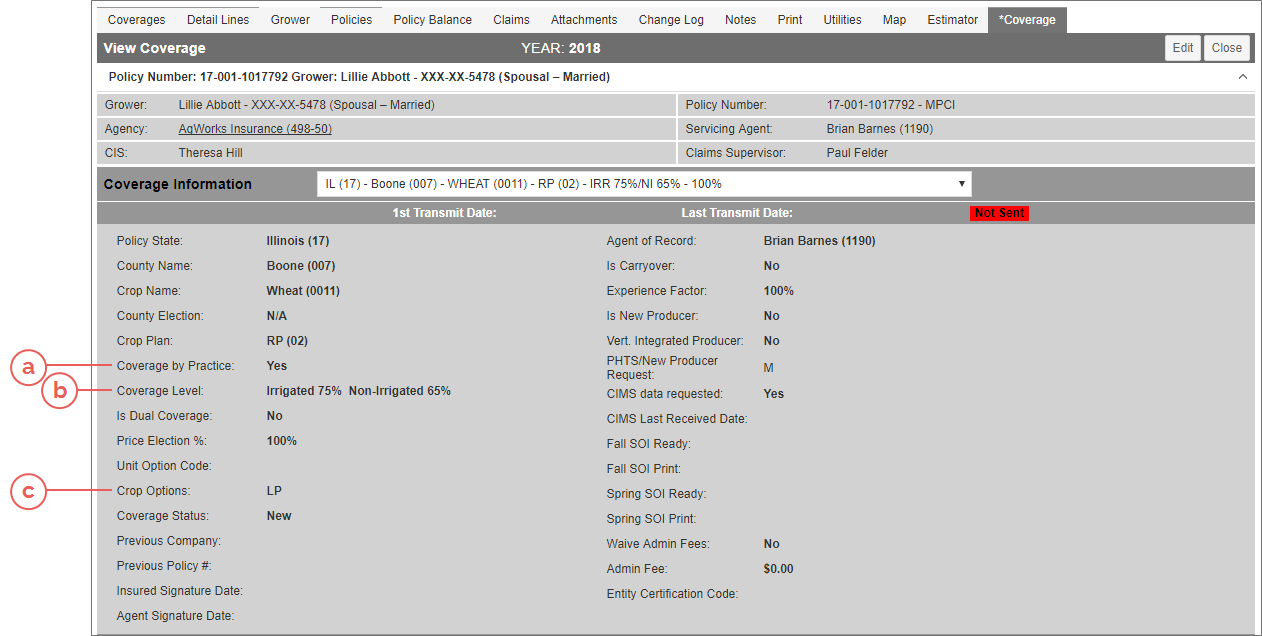Related
Coverage By Irrigation Practice (LP)
Overview
The Farm Bill authorized separate coverages by Irrigated and Non-Irrigated Practices for the 2015 and succeeding Reinsurance Years. When available in the ADM, Insureds can elect different Coverage Levels for Irrigated and Non-Irrigated acreage. RMA added a new option code, “LP”, to account for the Coverage Level by Practice election.
To accommodate this change, the coverage pages have been updated to display this new option code for selection when available for the State/County/Crop. Suspension logic and detail lines were updated for this change. Rating was updated to use the Irrigated Coverage Level on Irrigated Lines and Non-Irrigated Coverage Level on Non-Irrigated Lines when determining the guarantee and premium.
Consult the actuarial documents for LP availability and Sales Closing Dates by state/county/crop.
To allow a user to add different Coverage Levels for Irrigated and Non-Irrigated practices, a Coverage by Practice checkbox is displayed on the Add New/Maintain Coverage and Add New MPCI Policy pages.
| a. | When this checkbox is marked, in the Coverage Level field, the System displays two dropdowns for indicating the Irrigated (IRR) and Non-Irrigated (NON-IRR) Coverage Levels. |
| b. | Then, once the Coverage Levels are selected, in the Crop Options box, “LP – Coverage by Practice” displays, grayed out, if it is available for the RY/State/County/Crop/Type and it is automatically applied to the detail line and moved to the Selected Options box. |
If the Coverage by Practice checkbox is marked but the Coverage Levels are the same for each practice, the System will warn the user on save; this issue must be corrected before Mark Complete or the coverage will be suspended.
If the Coverage by Practice checkbox was selected for the coverage on the Add New/Maintain Coverage page and the “LP” option is selected and available for the RY/State/County/Crop/Type (if applicable)/Plan/Coverage Type, then “Yes” is displayed in the Coverage by Practice field (a), both coverage levels are shown the Coverage Levels field (b), and “LP” is displayed in the Crop Options field (c).
The warning and suspension that trigger when a new coverage by type is added for a crop that allows new types to be added after the Sales Closing Date (e.g., Dry Peas) have been updated to account for the Coverage by Practice (LP option). Now, on save of a coverage being added after the Sales Closing Date (i.e., the signature date is after the modified SCD) where the LP option exists, if the Coverage Level is not equal to the lowest existing Coverage Level for RY/State/County/Crop/Practice, then a warning will display. In addition, at Mark Complete, if a coverage has been added after the Sales Closing Date (i.e., the signature date is after the modified SCD), the LP option exists, and the coverage level is not equal to the lowest existing Coverage Level for the RY/State/County/Crop/Practice, then a suspension will trigger.
EXAMPLE
Dry Peas allow for separate Coverage Levels by Practice. In this example, the LP option is elected on the Dry Pea Coverages, so separate Coverage Levels are now allowed by Type and Practice. Assume the following coverages existed by the Sales Closing Date:
Dry Peas - Spr Large Kabuli Chickpeas - IRR 70%/NI 65%
Dry Peas - Spr Lentils - IRR 75%/NI 60%
After the Sales Closing Date but prior to the Acreage Reporting Date, a new coverage is added for Spr Smooth Green and Yellow Dry Peas. Then, since the Spr Smooth Green and Yellow Dry Peas are being added after the Sales Closing Date, they must have an Irrigated Coverage Level of 70% since this is the lowest existing Irrigated Coverage Level and a Non-Irrigated Coverage Level of 60% since this is the lowest existing Non-Irrigated Coverage Level.
If, at Mark Complete, the Coverage by Practice checkbox is marked and the Coverage Levels are the same for both Irrigated and Non-Irrigated Practices, the coverage will suspend.
For HR-ACE coverages with Coverage by Practice elected, the System will display a warning on save of the coverage and will trigger a suspension at Mark Complete if the Irrigated and High Risk Coverage Level is not less than the Irrigated base Coverage Level. The same warning and suspension will be triggered when the Non-Irrigated High Risk Coverage Level is not less than the Non-Irrigated base Coverage Level. The one exception to this is when the base coverage is RP or RPHPE and the High Risk coverage is YP; in which case, equal coverage levels can exist.
With STAX
Upon Mark Complete of either a STAX coverage or MPCI coverage, if the STAX coverage has been elected as a companion coverage and a link has been established between an MPCI (CCIP or ARPI) coverage record and the STAX coverage record, the System will validate that the allowable coverage has not been exceeded.
If it has been exceeded, the System will warn the user: "The combination of the STAX Coverage elections and the Related MPCI Coverage Level exceeds the allowable limit. The STAX Coverage Range must be reduced."
Coverage Limitations are determined as follows:
| • | If STAX coverage is Plan 35 or 36 and MPCI coverage is CCIP (Plan 01, 02 or 03), STAX Coverage Range + MPCI (CCIP) Coverage Level must be < or = the Area Loss Trigger elected on the STAX Coverage for the same Practice/Type |
EXAMPLE
Plan 35 Coverage Range = 20%
Plan 35 Area Loss Trigger = 90%
Plan 01 Coverage Level = 75%
These election exceed the maximum allowed.
Area Loss Trigger = 90%
75% + 20% = 95%
| • | If STAX coverage is Plan 35 or 36 and MPCI coverage is ARPI (Plan 04, 05 or 06), STAX Coverage Range must be < or = the Limit contained in ADM for the Protection Factor elected on Related Coverage for the same Practice/Type |
EXAMPLE
Bailey County, TX
Plan 35 Coverage Range = 20%
Plan 35 Area Loss Trigger = 90%
Plan 04 (AYP) Protection Factor = 110%
| • | SPOI for Plan 35/Bailey County, TX indicate that the Coverage Range of 20% exceeds the limit for the Plan 04 Protection Factor of 110%. |
| • | The Coverage Range would need to be reduced to 5% in order to meet the allowable limit for a Plan 04 Protection Factor of 110% (110% falls within the Maximum Protection Factor of 114%). |
| • | A Coverage Range of 20% would only be allowable if the Protection Factor for the Plan 04 (AYP) Related Coverage was 96%. |


